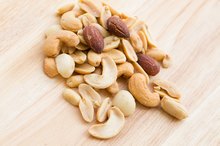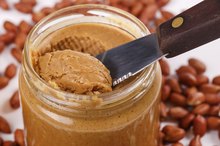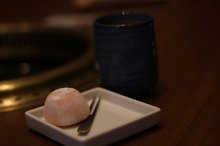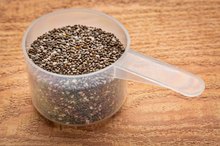What does fact checked mean?
At Healthfully, we strive to deliver objective content that is accurate and up-to-date. Our team periodically reviews articles in order to ensure content quality. The sources cited below consist of evidence from peer-reviewed journals, prominent medical organizations, academic associations, and government data.
The information contained on this site is for informational purposes only, and should not be used as a substitute for the advice of a professional health care provider. Please check with the appropriate physician regarding health questions and concerns. Although we strive to deliver accurate and up-to-date information, no guarantee to that effect is made.
Is Peanut Butter High in Cholesterol?
Peanut butter is an excellent source of nutrition. Required to contain at least 90 percent peanuts, it includes more than 30 vitamins and minerals. Peanut butter contains no cholesterol or trans fats, according to the National Peanut Board. In fact, studies show that peanut butter may even improve your levels of good cholesterol.
History
During the Civil War, peanut "porridge" became a protein staple for soldiers. In the late 1890s, a St. Louis physician made a ground peanut paste as an easy-to-eat protein source for elderly patients with bad teeth. Around the same time, cereal magnate Dr. John Harvey Kellogg filed for a patent for the "nut butter" he made to provide protein to his patients.
In 1908, Krema Nut Company in Columbus, Ohio, began selling peanut butter and continues to this day. Popular brands Peter Pan and Skippy originated in the 1920s and '30s, respectively.
- During the Civil War, peanut "porridge" became a protein staple for soldiers.
- Around the same time, cereal magnate Dr. John Harvey Kellogg filed for a patent for the "nut butter" he made to provide protein to his patients.
Benefits
Nutritional Facts of David Sunflower Seeds
Learn More
Peanut butter's make-up of monounsaturated fatty acids, protein, fiber and other bio-active constituents may help lower blood cholesterol levels, according to a Pennsylvania State University study led by Penny M. Kris-Etherton and published in the December, 1999, issue of "American Journal of Clinical Nutrition. 1"
The study compared a diet high in monounsaturated fats with a low-fat and an average high-fat diet. People with the high "bad" cholesterol levels experienced the biggest drop while on the monounsaturated fats diet. Their "good" cholesterol levels remained the same, unlike those on the low-fat diet.
The study also found that the diet high in monounsaturated fats reduced the risk of cardiovascular disease by 21 percent as compared to the average American diet.
- Peanut butter's make-up of monounsaturated fatty acids, protein, fiber and other bio-active constituents may help lower blood cholesterol levels, according to a Pennsylvania State University study led by Penny M. Kris-Etherton and published in the December, 1999, issue of "American Journal of Clinical Nutrition.
- The study also found that the diet high in monounsaturated fats reduced the risk of cardiovascular disease by 21 percent as compared to the average American diet.
Cholesterol
Your body creates both "good" HDL and "bad" LDL cholesterol. HDL cholesterol protects your arteries from getting clogged by LDL cholesterol. Not enough HDL cholesterol or too much LDL can put you at risk for heart attack, cardiovascular disease or stroke, according to the American Heart Association 1. About three-quarters of the cholesterol in your body originates from your liver and other cells, while the rest comes from ingesting animal products, the only food that actually contains cholesterol.
- Your body creates both "good" HDL and "bad" LDL cholesterol.
- Not enough HDL cholesterol or too much LDL can put you at risk for heart attack, cardiovascular disease or stroke, according to the American Heart Association 1.
Guidelines
History of PowerBilt Golf
Learn More
Some ways to help manage blood cholesterol include exercising regularly and eating a balanced diet with limited trans fats. This includes consuming smaller portions of meat and high-fat cheeses and a eating good variety of fruit, vegetables, grains, fish and legumes. Peanuts, considered a legume, are high in protein, fiber and antioxidants.
Ways to Enjoy Peanut Butter
Spread peanut butter on a whole-wheat tortilla or pita, which you can roll up.
Slice a banana lengthwise in half, spread with peanut butter and close.
Cut up an apple and spread peanut butter on it.
Dip sliced vegetables in peanut butter.
Add peanut butter to your morning smoothie.
- Spread peanut butter on a whole-wheat tortilla or pita, which you can roll up.
Related Articles
References
- American Heart Association: About Cholesterol
- Guasch-Ferré M, Liu X, Malik VS, et al. Nut consumption and risk of cardiovascular disease. J Am Coll Cardiol. 2017;70(20):2519–2532. doi:10.1016/j.jacc.2017.09.035
- Bes-Rastrolio, M.; Wedick, N.; Martinez-Gonzalez, M. et al. Prospective study of nut consumption, long-term weight change, and obesity risk in women. Am J Clin Nutr. 2009 Jun;89(6):1913-9. DOI: 10.3945/ajcn.2008.27276
- Bonnefont-Rousselot, D. Resveratrol and cardiovascular diseases. Nutrients. 2016 May;8(5):250. DOI: 10.3390/nu8050250
- American Academy of Allergy, Asthma, and Immunology (AAAAI). Newly Issued Clinical Guidelines from NIAID Recommend Early Peanut Intervention, Not Avoidance. Milwaukie, Wisconsin: AAAAI; issued January 5, 2017.
Writer Bio
Lorraine Shea writes about yoga, fitness, nutrition, healing, philosophy, art, decorating and travel for magazines and websites including Fit Yoga, Pilates Style and Country Accents. She teaches Anusara-style yoga and specializes in breath technique, active relaxation and therapeutics. She has a B.A. in English from New York University.









